Tonight, the Yankees and Mets begin their annual Interleague series: Two games at Citi Field in Flushing Meadow, Queens, followed by two games at the new Yankee Stadium in the South Bronx.
Both stadiums opened in 2009. From 1964 to 2008, the Mets played at Shea Stadium. So did the Yankees, in 1974 and 1975, while the old Yankee Stadium, which opened in 1923, was being renovated.
What was it like to see a Mets game at Shea? This time, my "Faux Flashback" is one that I could have done, as I began this blog in 2007.
Let's go back in time to 2000, when the World Trade Center still stood, Bill Clinton was President, Rudy Giuliani was a popular Mayor despite an apparent slight tinge of racism, the idea of Donald Trump becoming President was utterly ridiculous, Met fans thought the Atlanta Braves were real rivals, the Houston Astros were still in the National League, the Washington Nationals were still the Montreal Expos; Tommie Agee, Tug McGraw and Gary Carter were still alive; Bob Murphy and Ralph Kiner were not only still alive, but still broadcasting; and it looked like an actual Subway Series was going to happen -- and, for the only time since 1956, it did.
Updates will be in italics.
*
Before You Go: If you read this blog regularly, there is a 99 percent chance that you live in the New York Tri-State Area. So you've seen a weather forecast, and you won't have to worry about things like time zones, what to pack for the plane/train/bus, your passport or changing your money.
Tickets. The baseball seating capacity at Shea Stadium was long listed as 55,101, then 55,601. These days, it's listed as 57,333. Barring games against the Yankees or the Atlanta Braves, they're not likely to approach a sellout. The Mets averaged 33,650 fans per game in 1999, so you should be able to get a seat.
Note that the following ticket prices are guesses, based on my memory, and may not be correct. If you can find the actual prices, let me know in the Comment section.
Note that the following ticket prices are guesses, based on my memory, and may not be correct. If you can find the actual prices, let me know in the Comment section.
Here are the Mets' ticket prices: Box seats (orange): $45. Loge (blue): $30. Mezzanine (green) and last 6 rows of Loge: $24. Upper (red) and last 6 rows of Mezzanine: $18. Last 6 rows of Upper: $12.
Getting There. Since most people reading this will be local, posting the plane, bus and (except for the Subway) train information does not apply. If you are local, then you know how to do this: Take the Number 7 train, known as the International Express (even when it's a Local) for all the different ethnicities in the neighborhoods that it goes through. Take it to Willets-Point-Shea Stadium. The fare is $1.50.
Getting There. Since most people reading this will be local, posting the plane, bus and (except for the Subway) train information does not apply. If you are local, then you know how to do this: Take the Number 7 train, known as the International Express (even when it's a Local) for all the different ethnicities in the neighborhoods that it goes through. Take it to Willets-Point-Shea Stadium. The fare is $1.50.
Now, the fare is $2.75, and that station is named "Mets-Willets Point."
Alternatively, if you're coming from Port Authority Bus Terminal, you can take the E train to Jackson Heights-Roosevelt Avenue, then go upstairs and transfer to the 7, where the station will be known as 74th Street-Broadway. Either way, it should take about 35 minutes. If you're coming from Grand Central Terminal, or any Subway or Metro-North line going into Grand Center, again, take the 7, and it should take about 32 minutes.
Alternatively, if you're coming from Port Authority Bus Terminal, you can take the E train to Jackson Heights-Roosevelt Avenue, then go upstairs and transfer to the 7, where the station will be known as 74th Street-Broadway. Either way, it should take about 35 minutes. If you're coming from Grand Central Terminal, or any Subway or Metro-North line going into Grand Center, again, take the 7, and it should take about 32 minutes.
If you're coming from Penn Station, you may be better off following the Port Authority alternate route, or (if you don't mind paying a little extra) taking the Long Island Rail Road (LIRR) to its Mets-Willets Point station. The fare will be $5.25 outbound on weeknights (remember, rush hour), and $3.50 outbound on weekends and back inbound. So, round-trip, either $8.75 or $7.00.
Now, the fare is $8.25 outbound on weeknights, $6.00 outbound on weekends and back inbound. So, round-trip, either $12.00 or $14.25.
If you want to drive, it's 10 miles from Times Square by the closest road route. You'll have better parking options than at Yankee Stadium (old or new). Shea Stadium is at 126th Street & Roosevelt Avenue. It is bounded by Roosevelt on the south, 126th and the Van Wyck Expressway on the east, Northern Boulevard on the north and the Grand Central Parkway on the west.
If you're coming from Manhattan, don't fool around with the streets: Take the Subway. If you're coming from points north (The Bronx, Connecticut, or Westchester on up), take any road leading to Interstate 87 (the New York State Thruway north of the City, the Major Deegan Expressway inside), to the Triborough/Robert F. Kennedy Bridge, to the Grand Central, and take Exit 9E and follow the signs.
If you're coming from Long Island, take the LIRR. The Port Washington Line will take you directly to a station across Roosevelt Avenue from the ballpark, adjacent to the elevated 7 line. From the other LIRR lines, take any westbound train to Jamaica, and transfer to any Penn Station-bound train that will take you to Woodside. From there, switch to the 7 Train. If you'd rather drive in from The Island, take any westbound highway to the Van Wyck.
If you're coming from Brooklyn, it depends on whether you're coming from the west or east side of it. From the west side, get to the Brooklyn-Queens Expressway (BQE), stay on it until it becomes the Grand Central, and then follow the directions from points north. From the east side, take either the Shore Parkway or the Jackie Robinson Parkway to the Van Wyck, and follow the signs. If you're coming from Staten Island, get to the Verrazano-Narrows Bridge, and follow the directions from Brooklyn (and take your pick).
If you're coming from New Jersey, it's probably best to take a bus into The City and then take the 7 Train from Port Authority; or to take a train in and then take the LIRR from Penn Station. But if you'd rather drive, then, from North Jersey, get to the George Washington Bridge, and then follow the directions from points north. From Central Jersey, get to the New Jersey Turnpike, and take Exit 13 for the Goethals Bridge, and, from there, follow the directions from Staten Island.
The official address is 123-01 Roosevelt Avenue. All addresses in the Borough of Queens are hyphenated like that. So think of it as 123 blocks from the East River. It's 11 miles east of Port Authority.
Once In the City. You're already there, so this usual category is pointless. Let's move on.
Going In. The William A. Shea Municipal Stadium opened on April 17, 1964, after the Mets had played their 1st 2 seasons, 1962 and 1963, at the Polo Grounds, home of the baseball version of the New York Giants.
Bill Shea was a powerful New York lawyer whom Joan Whitney Payson, the only member of the Giants' board of directors who voted against moving to San Francisco in 1957, when the Brooklyn Dodgers also decided to move to Los Angeles, hired to help her bring National League baseball back to New York.
Every year from 1964 until his death in 1991, Shea would present a wreath of flowers in a horseshoe shape to the Mets' manager. A horseshoe is, in legend, a symbol of good luck. But Shea apparently never realized that his presented horseshoes were always pointed down, so that "the luck would run out."
One of the main features of Shea Stadium when it opened is that, unlike previous New York ballparks, it had lots of parking, enough spaces for 12,000 cars. This gives the Mets at least one huge advantage over the Yankees. Citi Field has about that many parking spaces again. Parking costs $12.
Now, parking is $22.
Bill Shea was a powerful New York lawyer whom Joan Whitney Payson, the only member of the Giants' board of directors who voted against moving to San Francisco in 1957, when the Brooklyn Dodgers also decided to move to Los Angeles, hired to help her bring National League baseball back to New York.
Every year from 1964 until his death in 1991, Shea would present a wreath of flowers in a horseshoe shape to the Mets' manager. A horseshoe is, in legend, a symbol of good luck. But Shea apparently never realized that his presented horseshoes were always pointed down, so that "the luck would run out."
One of the main features of Shea Stadium when it opened is that, unlike previous New York ballparks, it had lots of parking, enough spaces for 12,000 cars. This gives the Mets at least one huge advantage over the Yankees. Citi Field has about that many parking spaces again. Parking costs $12.
Now, parking is $22.
Gate A is at the left field corner, Gate B by 3rd base, Gate C behind home plate, Gate D by 1st base, and Gate E at the right field corner. At Gate A is a mural of the team's 1986 World Series win, and at Gate E is one of the 1969 title. If you're coming off the Subway, especially if you have already ordered your ticket, you're likely to go in through Gate D or E.
From 1964 to 1980, Shea's exterior was decorated with blue and orange rectangular panels, matching the team's colors -- which, like those of the Knicks, founded in 1946 and preceding the Mets, reflect the colors of the City's founders, the Dutch. The fact that the Dodgers wore blue and the Giants wore orange is a nice coincidence, and it made for convenient symbolism of the old rivals coming together in common cause (loving New York City, loving baseball, loving the National League, and hating the Yankees), but the color scheme was already present on a New York team before the Mets. (And the Islanders.)
After the 1980 season, the new owners, Nelson Doubleday and Fred Wilpon, gave the stadium its first and, so far, only major overhaul. Now, the exterior is a bright blue, and decorated with neon figures of ballplayers in action poses.
Shea points due east. The field is real grass: Despite having been built as a multipuprose stadium with movable field level stands to adjust between baseball and football, and having the round structure of some of the game's "giant concrete ashtray" or "cookie-cutter" stadiums, one of Shea's saving graces is that it has never had artificial turf.
From 1964 to 1980, the seating color scheme was as follows, from bottom to top: Field level, yellow; Loge, red; Mezzanine, blue; and Upper, green.
Since 1981, it's been: Field, orange; Loge, blue; Mezzanine, green; and Upper, red.
Shea is a pitcher's park, and always has been, due to the distances to the fence and the wind, which, while not as bad as that in Wrigley Field in Chicago, let alone Candlestick Park in San Francisco, can be bad enough for anyone hoping to crank one out.
The distances had been established as 341 feet to the foul poles, 358 to straightaway left and right, 371 to the power alleys, 396 to either side of straightaway center, and 410 to straightaway center. As Nathan Salant put it in his 1979 book This Date In New York Yankees History, "Dull and symmetrical, just like the Mets."
When the Jets moved out in 1984, this eliminated the need for the movable baseline stands, so the distances to the poles could be shortened to 338. This did not, however, appreciably increase the offense at Shea: While the Mets did improve, it was mainly because their pitching and fielding were getting a lot better.
(Even at their worst, 1962 to 1968, 1977 to 1983, and 1992 to 1996, they could always be counted on to provide what's commonly called "oafish clout," from such oafs as Jim Hickman, Dave Kingman, Lee Mazzilli and Bobby Bonilla.)
The longest home run at Shea Stadium appears to have been a 515-foot blast by Dave Kingman on August 14, 1981. (Darryl Strawberry hit the longest home run in Met history, 535 feet, in 1988, but that was in Montreal.) Shea doesn't have much of its grandstand in fair territory, so it's very hard to hit a fair ball into the upper deck. The only player who ever did that was Met center fielder Tommie Agee on April 10, 1969.
After Agee died in 2001, the spot where that homer landed, about 480 feet from home plate, was painted with the date, his name, and his uniform Number 20. As far as I know, no effort was made to save this piece of concrete and put it in the team Hall of Fame at Citi Field.
Gate E, at the right field corner.
A similar ticket booth is at Gate A.
After the 1980 season, the new owners, Nelson Doubleday and Fred Wilpon, gave the stadium its first and, so far, only major overhaul. Now, the exterior is a bright blue, and decorated with neon figures of ballplayers in action poses.
Shea points due east. The field is real grass: Despite having been built as a multipuprose stadium with movable field level stands to adjust between baseball and football, and having the round structure of some of the game's "giant concrete ashtray" or "cookie-cutter" stadiums, one of Shea's saving graces is that it has never had artificial turf.
From 1964 to 1980, the seating color scheme was as follows, from bottom to top: Field level, yellow; Loge, red; Mezzanine, blue; and Upper, green.
Since 1981, it's been: Field, orange; Loge, blue; Mezzanine, green; and Upper, red.
Shea is a pitcher's park, and always has been, due to the distances to the fence and the wind, which, while not as bad as that in Wrigley Field in Chicago, let alone Candlestick Park in San Francisco, can be bad enough for anyone hoping to crank one out.
The distances had been established as 341 feet to the foul poles, 358 to straightaway left and right, 371 to the power alleys, 396 to either side of straightaway center, and 410 to straightaway center. As Nathan Salant put it in his 1979 book This Date In New York Yankees History, "Dull and symmetrical, just like the Mets."
When the Jets moved out in 1984, this eliminated the need for the movable baseline stands, so the distances to the poles could be shortened to 338. This did not, however, appreciably increase the offense at Shea: While the Mets did improve, it was mainly because their pitching and fielding were getting a lot better.
(Even at their worst, 1962 to 1968, 1977 to 1983, and 1992 to 1996, they could always be counted on to provide what's commonly called "oafish clout," from such oafs as Jim Hickman, Dave Kingman, Lee Mazzilli and Bobby Bonilla.)
The longest home run at Shea Stadium appears to have been a 515-foot blast by Dave Kingman on August 14, 1981. (Darryl Strawberry hit the longest home run in Met history, 535 feet, in 1988, but that was in Montreal.) Shea doesn't have much of its grandstand in fair territory, so it's very hard to hit a fair ball into the upper deck. The only player who ever did that was Met center fielder Tommie Agee on April 10, 1969.
After Agee died in 2001, the spot where that homer landed, about 480 feet from home plate, was painted with the date, his name, and his uniform Number 20. As far as I know, no effort was made to save this piece of concrete and put it in the team Hall of Fame at Citi Field.
Other notable home runs for distance at Shea include shots that hit the scoreboard by Eddie Mathews, Dick Allen and Willie McCovey; one by Hank Aaron that hit the center field flagpole; and a tremendous blast by Frank Robinson of the Baltimore Orioles in Game 5 of the 1969 World Series. While it wasn't particularly far, the 1st great home run in Shea Stadium history came in its 1st season, when it hosted the 1964 All-Star Game, and Johnny Callison of the Philadelphia Phillies hit what we would now call a walkoff home run to give the NL the win.
The most notable Met home runs at Shea have been those by Donn Clendenon and Al Weis in that same Game 5 in 1969 (enabling the Mets to clinch), Willie Mays' round-tripper in his return to New York in 1972, Gary Carter's drive in his Met debut on Opening Day 1985, Lenny Dykstra's walkoff homer in Game 3 of the 1986 NL Championship Series, Ray Knight's and Darryl Strawberry's homers in Game 7 of the 1986 World Series, and the 1999 postseason game-winners by Todd Pratt in Game 4 of the NL Division Series and Robin Ventura in Game 5 of the NLCS.
(This, of course, was before Benny Agbayani's walkoff in Game 3 of the 2000 NLDS, and Mike Piazza's home run in the 1st game back after the 9/11 attack.)
The Mets had to share Shea with the AFL's/NFL's Jets from 1964 to 1983 (as well as 1962 and 1963 at the Polo Grounds), the Yankees in 1974 and 1975, and the NFL's Giants in 1975 only. The Yankees also had to play a home game at Shea on April 15, 1998, due to an accident at Yankee Stadium that required a week's repair. (They then switched home dates in series with the Detroit Tigers to make this possible.)
Shea in its football setup, 1964 to 1983
At Shea, the Jets played the 1968 AFL Championship Game (beating the Oakland Raiders), a 1969 AFL Divisional Playoff (losing to the Kansas City Chiefs), and a 1981 AFC Wild Card game (losing to the Buffalo Bills). Shea was also the site of O.J. Simpson becoming the 1st player to rush for 2,000 yards in an NFL season, in 1973, leading the Bills over the Jets; and, in what remains the last NFL game played within New York City, Terry Bradshaw's last NFL game, leading the Pittsburgh Steelers over the Jets.
Tom Seaver and Joe Namath
No North American Soccer League team ever called Shea home, and most European and Latin American clubs making off-season tours of the United States have preferred to use either Yankee Stadium or the Meadowlands.
Pope John Paul II said Mass at Shea, and also Yankee Stadium and Madison Square Garden, in 1979. The Beatles played the 1st concert at Shea on August 15, 1965, and returned on August 23, 1966. The Summer Festival for Peace was held at Shea on August 6, 1970, a day-long fundraiser that featured Miles Davis, Paul Simon, John Sebastian of the Lovin' Spoonful, Creedence Clearwater Revival, Steppenwolf, and, in the last few weeks of her life, Janis Joplin.
Other famed Shea concerts include Grand Funk Railroad and Humble Pie in 1971, Jethro Tull in 1976, The Who and The Clash in 1982, Paul Simon & Art Garfunkel in 1983, The Police the same year, The Rolling Stones in 1989, and Elton John and Eric Clapton in 1992.
Billy Joel would play the last show at Shea in 2008, and invited the Beatles' Paul McCartney onstage to complete the circle. The next year, Sir Cute One returned the favor, playing the 1st concert at Citi Field and inviting BJ onstage.
Several movies have used Shea as a filming location: The baseball-themed Bang the Drum Slowly (though the fictional New York Mammoths wore uniforms resembling those of the Yankees), the film version of The Odd Couple (a phone call by Felix to the press box makes Oscar miss a triple play that saves the game for the Mets), The Wiz and Men In Black. Clips from the 1969 World Series were used in the film Frequency.
Frequency had just been released in 2000.
Food. One area where the Mets have always had the edge over the Yankees was in food. Kahn's hot dogs are better than any version of Yankee Franks, and the food courts at the foul poles have much better variety than anything served in The Bronx. It's also a little cheaper than what can be found at Yankee Stadium.
Team History Displays. This is one area where the Mets fall way short of the Yankees. I don't just mean the quantity and the quality of the history itself, I mean in the way they present it. There is a Mets Hall of Fame, but it is not on display in the fan-viewable areas. (This would be remedied at Citi Field.)
Members of the Mets Hall of Fame include, in their order of induction: Team founder-owner Joan Payson, manager Casey Stengel, 1st baseman-manager Gil Hodges, team president George Weiss, chief scout Johnny Murphy, team "godfather" Bill Shea; broadcasters Lindsey Nelson, Bob Murphy and Ralph Kiner; shortstop Bud Harrelson, right fielder Rusty Staub, pitchers Tom Seaver and Jerry Koosman, 1st baseman Ed Kranepool, left fielder Cleon Jones, catcher Jerry Grote, pitcher Tug McGraw, center fielder Mookie Wilson, and 1st baseman-broadcaster Keith Hernandez.
Since 2000, they've added: Catcher Gary Carer, center fielder Tommie Agee, general manager Frank Cashen, pitcher Dwight Gooden, manager Davey Johnson, right fielder Darryl Strawberry, pitcher John Franco and "catcher" Mike Piazza.
As the 3rd base coach in 1986, Harrelson is the only Met who has been on the field for 3 Pennants, while he and Davey are the only people who were in uniform for both of the Mets' World Series clinchers, albeit in Davey's case he was in uniform for the opposition in 1969, making the last out for the Orioles, a fly ball caught by Jones.
Bob and Johnny Murphy were not related, although Bob's brother Jack Murphy was a sportswriter who heavily lobbied for major league sports to come to his adopted hometown of San Diego, and the stadium used by the Chargers and formerly by the Padres was named in his honor until Qualcomm bought the naming rights. Johnny Murphy was a Yankee reliever in the 1930s and Weiss was a Hall of Fame GM for the Yankees, but neither is honored in Yankee Stadium's Monument Park. Only Stengel is honored in both ballparks.
The Mets have retired 3 numbers: Stengel's 37, Hodges' 14 and Seaver's 41. Of course, Jackie Robinson's Number 42 was universally retired in a 1997 ceremony at Shea Stadium (I was there, having taken my Grandma there to honor her favorite athlete of all time). Those retired numbers are now on the wall above the fence in the left field corner. Not officially retired, but rarely given out, are: 8, Gary Carter, catcher 1984-90; and 24, Willie Mays, center field 1972-73.
In the final season of the stadium, 2008, they gave Bill Shea a stanchion with his name on it that stood in for a "retired number."
Seaver was the only player with a serious Met connection named to The Sporting News' 100 Greatest Players in 1999.
On the wall above the fence in the right field corner are the "pennants" honoring the Mets' achievements: The 1969 and 1986 World Series wins, the 1973 Pennant, the 1988 NL Eastern Division title, and the 1999 Wild Card and Division Series win.
How it looked after the 2000 Pennant. They would be joined
by the 2006 Division title before Shea closed, and now the 2015 Pennant.
Also, the flags for the 1969 and 1986 World Championships fly in center field, flanking the main flagpole.
Videotapes (now DVDs) with the highlight films of the 1969 and 1986 World Series is available, as is a collection honoring the 1986 World Series (all 7 games, plus the clinching NLCS Game 6 in Houston).
Books about the Mets abound. Their early days were chronicled by New York newspapermen Jimmy Breslin in Can't Anybody Here Play This Game? (taken from a remark by Stengel) and Leonard Shecter's Once Upon the Polo Grounds. After the 1969 title, one of the best of the old New York baseball writers, Leonard Koppett, covered their lousy 1st 7 seasons and their "Miracle" 8th season in New York Mets: The Whole Story. Stanley Cohen wrote A Magic Summer: The Amazin' Story of the 1969 New York Mets. Books about the 1986 season include memoirs by Hernandez, Carter, Gooden, Strawberry and Wilson.
As the Mets' 40th and 50th Anniversaries, and the 15th, 20th, 25th and now 30th Anniversaries of their last World Series wins have come, more books about the 1986 title, and their entire history, have been written.
During the Game. For the most part, Met fans do not abuse fans wearing opposing teams' gear. But I wouldn't wear an Atlanta Braves cap or shirt to Citi Field. I definitely wouldn't wear Philadelphia Phillies stuff.
As for Yankee gear... The simple act of wearing Pinstripes or the Yankee cap inside the Mets' ballpark is enough for their fans to consider it a provocative act. Like being a Red Sox fan, being a Met fan means you have to hate the Yankees nearly as much as you love your own team. It's in their blood: Giant and Dodger fans hated the Yankees as much as they hated each other, and, with the creation of the Mets serving as the burying of the hatchet between the Hatfields and McCoys of baseball, they were united in the twin causes of loving the Mets and hating the Yankees.
I seriously doubt that they will start a fight with you, simply because you show up in your teams' colors. Still, if even one Met fan out of a thousand is willing to start a fight, that means, somewhere in the joint, there are between 10 and 55 fans who will want to. So be aware of the possibility.
And if they do give you some verbal, do your best to ignore them. Don't respond with anything harsher than, "We'll see what happens in this game."
Do not bring up the 24 World Championships to 2 (now 27 to 2): They'll just say the Yankees "cheated" or "bought their titles." As if the '86 Mets didn't have the biggest payroll in the NL at the time, and the failed Mets of 1987 until now haven't had one of the top 3 payrolls in the NL all those years, and Mike Piazza isn't also a rumored steroid user.
The Mets, since birth, have had a theme song, "Meet the Mets." I have to admit, it's a better song than "Here Come the Yankees," even if "the butcher and the baker" and others (the milkman?) have been mostly replaced by supermarkets.
A new "disco" version was done for Channel 9 broadcasts in 1975, and yet another, more family-friendly, version in 1984. That was replaced by the "Teamwork to make the dream work" fight song for 1986.
Yankee Fans like to call Shea "The Flushing Toilet." It's not that bad. However, the corridors are a dingy gray, making it look worse than it is. They could also use some better trash pickup. And while their aisles, rows (therefore legroom), corridors, concession stands and bathrooms are all wider than at Yankee Stadium, the bathrooms are not as good as those in the Bronx ballyard.
Mr. Met, a guy in a Met uniform (Number 00) with a big baseball head, appears to have been the original man-in-a-suit mascot at big-league baseball games. Don't worry, he's designed to be harmless, unlike the Phillie Phanatic, whose "tongue," however inadvertently, has hurt a few people. He's the only guy who can smile all the way through 81 Met home games, and he's the only Met who's allowed to have a big head.
Unquestionably, the New York Tri-State Area's best
major league sports mascot. Who else is there? N.J. Devil?
Mr. Met has occasionally dressed in other costumes, including a superhero (Hero Met), The Fonz, Vegas Period Elvis, and others. Sometimes, he shows up with his wife, Mrs. Met, a.k.a. Lady Met. Sometimes, the Little Mets show up, too. But not on a school night.
In 1979, the Mets tried to bring in a new mascot: Mettle the Mule. This was a major public relations blunder. First of all, Mr. Met is revered by Met fans. Second of all, a mule had already been used by the Kansas City/Oakland A's. And 3rd of all, Mettle (meaning "strength" or "courage," and having "Met" in the name) was introduced to the fans by pulling a wagon around the field. And seated in the wagon was the owner at the time, Lorinda de Roulet, daughter of Mrs. Payson, who died in 1975. Mrs. Payson was beloved, as the woman who brought the Mets to the NL-deprived fans. Mrs. de Roulet was despised, as the woman who let team chairman M. Donald Grant do whatever he wanted, including trade away the players of the '69 and '73 Pennant winners, even going so far as to drive Seaver away from the team. Like Dandy, the weird mascot the Yankees introduced the next season, Mettle the Mulet was quickly scrapped, and has not been missed.
Pretty soon, even Mrs. de Roulet couldn't stand the thing anymore.
Oy vey, the planes! I once tried to count the number of planes going overhead at a Met game, and gave up after 75. The truly loud ones are only those taking off from neighboring LaGuardia International Airport. The ones landing go on a different runway, further away, and are usually not disruptive. The old "plane race" on the video board (which inspired the Yankees to do "The Great City Subway Race") has been retired.
When a Met hits a home run, the Home Run Apple is activated. Placed in Shea's center field after Nelson Doubleday and Fred Wilpon bought the team from Mrs. Payson's estate in 1980, it was supposed to be a play not just on the New York nickname "the Big Apple," but also on the slogan of the time: "The New Mets: The Magic Is Back." It was a magician's black top hat, inverted, with the white letters "HOME RUN" on the front, and a big red apple with a Met logo on it would rise out, and the logo would light up.
In 1998, when an accident forced a brief closure of the old Yankee Stadium and 1 Yankee home game to be moved to Shea, Strawberry, who hit more homers at Shea than anyone, hit one for the Yankees, and the apple was rigged to rise to only half its height, so only the top half of the Met logo could be seen, showing the stylized New York skyline but not the word "Mets." I thought it was a good touch.
Knowing that Shea would be demolished, an Internet campaign went up to "Save the Apple." It worked: The old apple, which really was in bad shape, was restored and put outside Citi Field, as a meeting place similar to the old Yankee Stadium's Big Bat. A new, larger apple was put in the center field hitter's background inside the new park.
The main Met fans' chant is, of course, the rhyming, "Let's go, Mets!" For many years, in the 1990s and 2000s (but I haven't seen them do it at Citi Field), they would, during some late rallies, cue up the scene from the movie Network, when Peter Finch's news anchor Howard Beale demands that people yell out their windows, "I'm as mad as hell, and I'm not going to take this anymore!" so that it's rigged to say, "I want you to get up now. I want all of you to get up out of your chairs. I want you to get up right now and go to the window. Open it, and stick your head out, and yell... LET'S GO METS!"
The Mets hold auditions for National Anthem singers, instead of having a regular. In the 7th Inning Stretch, after Mr. Met leads fans in "Take Me Out to the Ballgame," the stadium speakers will play Newark native Lou Monte's half-Italian-half-English song "Lazy Mary." Why? Probably due to New York's huge Italian community and the song's inclusion in the New York-based film The Godfather. (Never mind that the recording was released in 1958, or 13 years after the film's opening wedding scene, which includes the song.)
If the Mets win, their postgame victory song last year was, ironically, "L.A. Woman" by the Doors, with its chorus of "Mr. Mojo Risin'," an anagram of their lead singer's name, Jim Morrison. In this season (2000), it's the impossibly annoying "Who Let the Dogs Out?" by the Baha Men.
Today, at Citif Field, after the game, if the Mets win, they play "Taking Care of Business" by Bachman-Turner Overdrive. Eventually, win or lose, even though Billy Joel is a Yankee Fan, the Mets play his song "New York State of Mind."
After the Game. If you’re looking for a postgame meal (or even just a pint), you're going to have to get in your car or on the Subway, as Shea is an island in a sea of parking. Sadly, Rusty's, Staub's once-wildly popular Midtown East Side restaurant which he based on the cuisine of his native New Orleans, is long gone.
A bar associated with the 1980s Mets, because some of their players liked to get tanked there, is Finn MacCool's, at 205 Main Street in Port Washington, 6 blocks west of the Port Washington station on the LIRR. If you want to go, go to the LIRR station across Roosevelt Avenue, and get on an eastbound train instead of a westbound one.
Sidelights. This could get long, so I'll limit it to Met-centric sites. Across Roosevelt Avenue and the LIRR tracks is Flushing Meadow-Corona Park, site of the 1939-40 New York World's Fair (the Queens Museum is pretty much all that's left of it) and the 1964-65 New York World's Fair (a few more structures survive, including the Unisphere globe).
Not destroyed by the Men In Black. That was just a movie.
It includes the Billie Jean King National Tennis Center, home of the U.S. Open, including the main stadium, named for tennis legend Arthur Ashe, and a smaller one that used to be the main stadium, named for music legend Louis Armstrong, who lived nearby in Corona, loved baseball, had season tickets for the Yankees until Shea opened, then became a Met fan, and, for some reason, loved tennis, going to the Open when it was still being held at the Forest Hills Stadium.
You might be cool, but you'll never be Satchmo talking on the phone
while wearing a Mets cap and pajamas in his home recording studio cool.
Funny, but when Jack Klugman wore pretty much the same outfit
as Oscar Madison on The Odd Couple, he wasn't nearly so cool.
Louis Armstrong Stadium was originally the Singer Bowl, built for the '64 World's Fair. It was converted into 2 venues, attached to each other, for the U.S. Open, and reopened in 1978, seating 18,000. When Arthur Ashe Stadium opened in 1997, Armstrong Stadium had its top deck removed, and capacity was reduced to 10,000.
It will soon be demolished and replaced with a 15,000-seat stadium, also named for Armstrong, in time for the 2018 Open.
The BJK NTC at FMCP, as it currently stands.
Ashe Stadium in the center, Armstrong Stadium to the right.
In their 1st 2 seasons, 1962 and 1963, the Mets played at the Polo Grounds. It was home to the baseball Giants from 1911 to 1957 (and a previous stadium on the site, which burned down, hosted them from 1891 to 1911), the Yankees from 1913 to 1922, and the football Giants from 1925 to 1955. It hosted a few Army-Notre Dame games, including the one in 1924 where Notre Dame's backfield ran all over the place and was nicknamed The Four Horsemen by legendary sportswriter Grantland Rice.
Fordham's football team also played some home games there, including a famous scoreless tie with Pittsburgh in 1937, when ended the season ranked Number 1 and Fordham, with a line known as the Seven Blocks of Granite and including Brooklyn native Vince Lombardi and South River, New Jersey's Alex Wojchiechowicz (both in the Pro Football Hall of Fame), finished at Number 3.
Jack Dempsey knocked out Luis Firpo there in 1923, retaining the heavyweight title despite Firpo knocking him all the way out of the ring at one point. Joe Louis came from behind to knock out Billy Conn there, retaining the title in 1941. Floyd Patterson became the 1st fighter ever to regain the heavyweight title, knocking out Ingemar Johansson there in 1960, after Ingo had knocked him out at Yankee Stadium the year before.
Demolition of the Polo Grounds began on April 11, 1964, by the same company and using the same wrecking ball, painted to look like a baseball, that had demolished Ebbets Field. This was right before Shea opened -- in other words, if Shea hadn't been ready on April 17 (and it nearly wasn't), the Mets would have been screwed, because the Yankees weren't going to let them in.
Polo Grounds Towers opened on the site in 1966. At the entrance to one of those towers, roughly where home plate was, is a plaque honoring the old stadium. Just to the north is a playground (not an actual field) named Willie Mays Field. Across 155th Street is Rucker Park, home to a renowned summer basketball tournament. 2955 Frederick Douglass Blvd. (what 8th Avenue is called above Central Park). B or D train to 155th Street. Definitely a place for a sports fan to visit during the day. Definitely not a place for anyone not from Harlem or Washington Heights to visit at night.
Speaking of Ebbets Field, the home of the Brooklyn Dodgers from 1913 to 1957 stood at 1700 Bedford Avenue, at the corner of Sullivan Place. B or Q train to Prospect Park. Again: Visit during the day, not at night.
It was demolished in 1960, and in 1962, Ebbets Field Apartments opened on the site. Across McKeever Place was Jackie Robinson Intermediate School. It is now named Ebbets Field Middle School.
There have seen been plenty of memorials erected to Jackie, including the Rotunda at Citi Field, and a statue of him and Dodger Captain Harold "Pee Wee" Reese outside the current home of Brooklyn baseball, MCU Park (named for the company formerly known as Brooklyn Union Gas and KeySpan).
That's the Coney Island Parachute Jump in the background,
over the stadium's right field corner. It's restored so it won't collapse,
but it's no longer a working ride.
The ballpark opened in 2001, and the Brooklyn Cyclones, named for the nearby roller coaster, won the New York-Penn League Pennant that year, but haven't won it since. They still sell the place out nearly every game, though. Their season starts in mid-June, always with a home-and-home 2-game series with their arch-rivals, the Staten Island Yankees.
1904 Surf Avenue. D, F, N or Q train to Stillwell Avenue-Coney Island. It's a relatively safe neighborhood these days, but it takes an hour to get there on the Subway from Midtown Manhattan.
*
As long as the Mets aren't playing the Yankees, with a deep hatred that goes back well before the Mets were even an idea, Shea Stadium is well worth a visit.
Just be careful not to provoke anybody. Especially if you're a Yankee Fan going for an Interleague game! Remember: It's better to be an uninjured coward than a hospitalized tough guy.



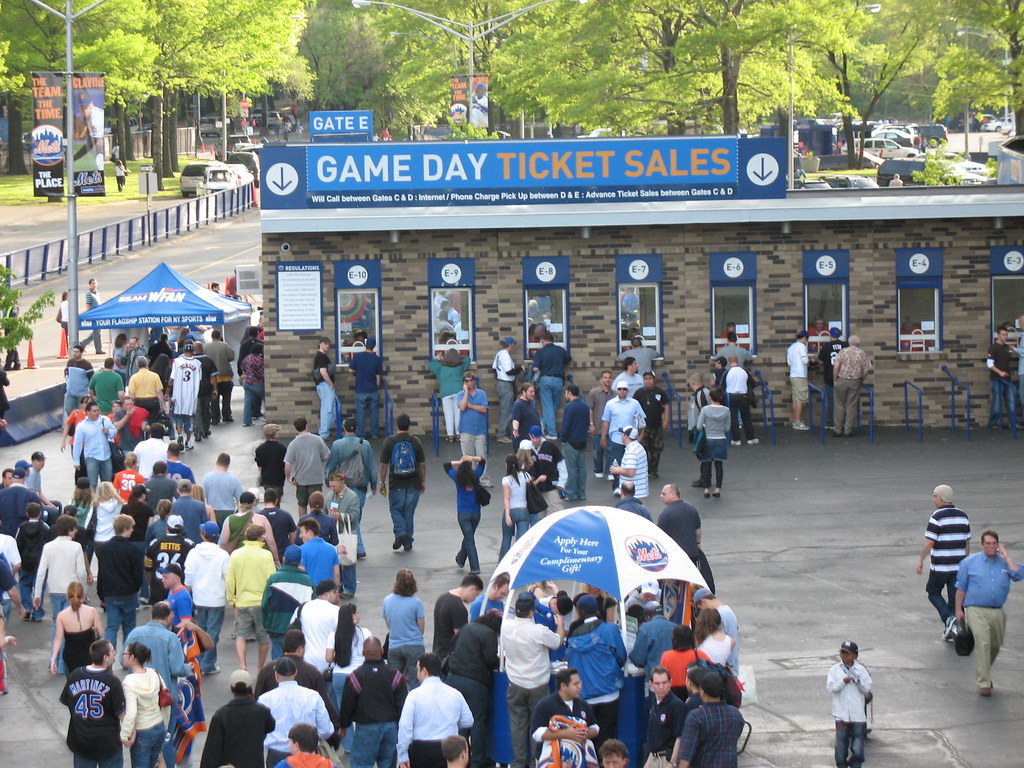
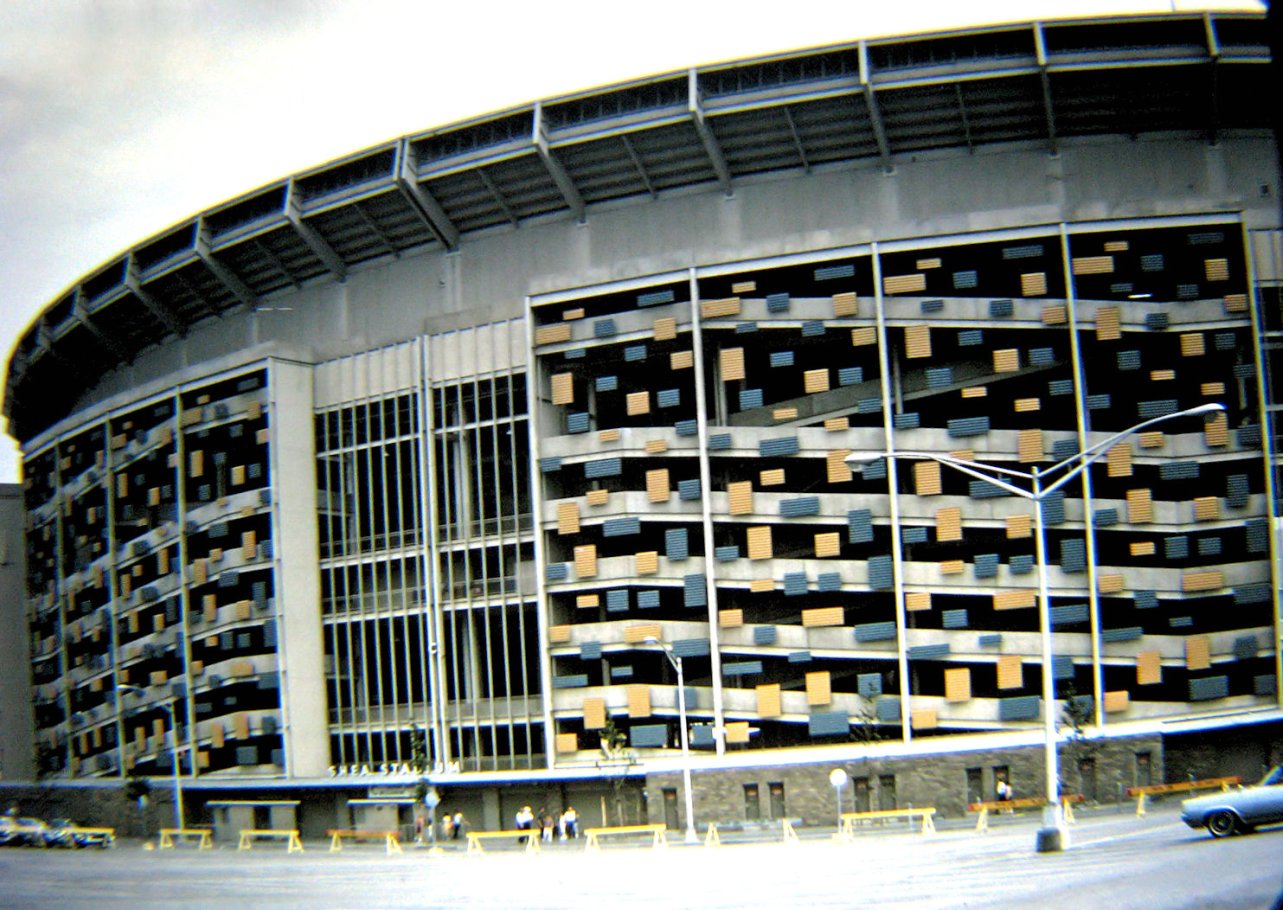

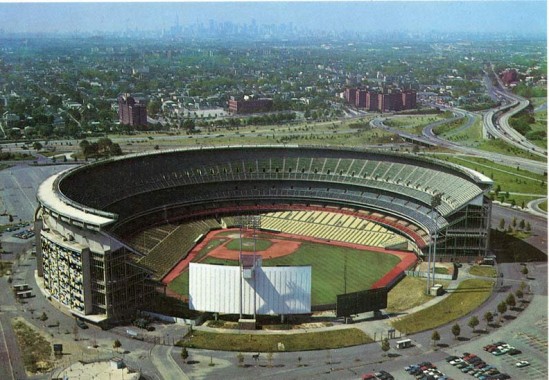

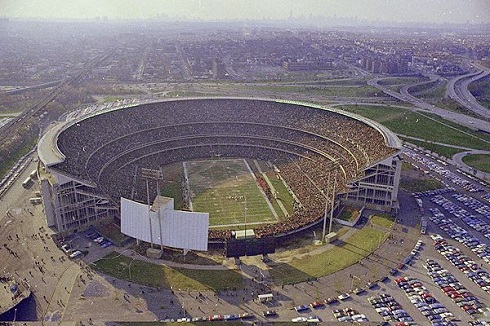

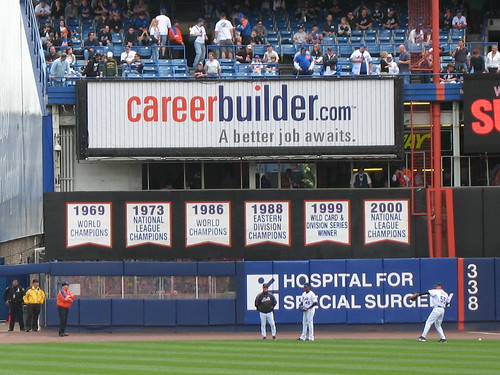




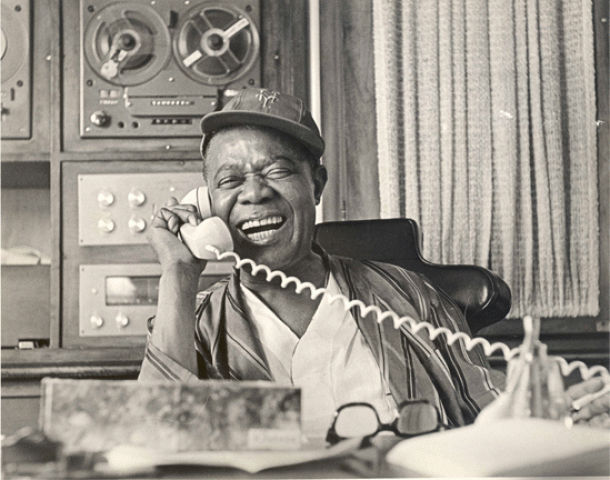
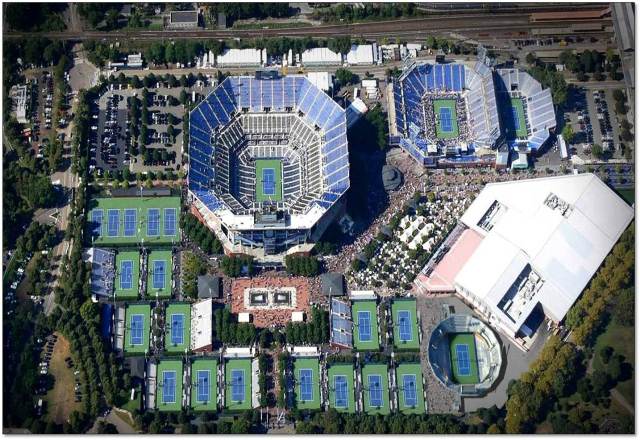


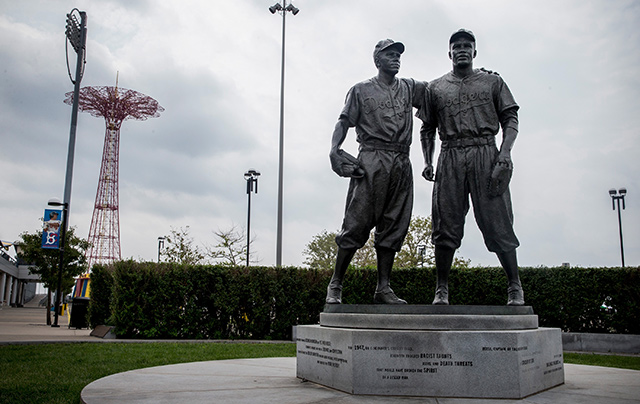
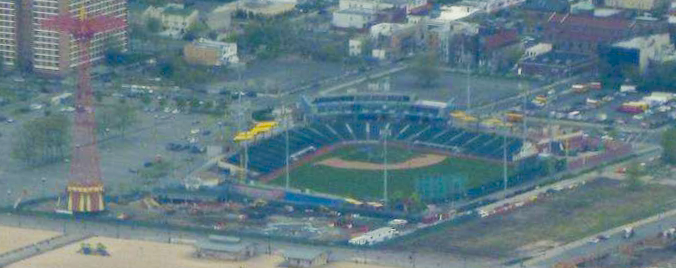

No comments:
Post a Comment